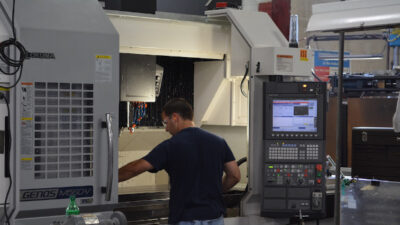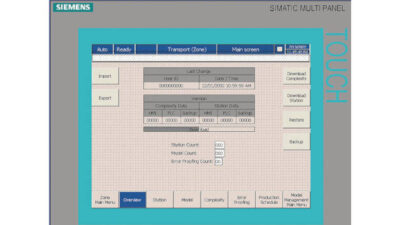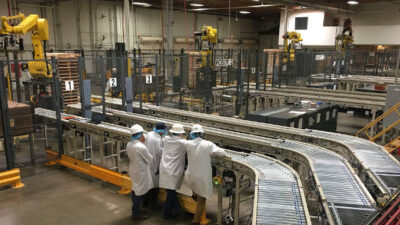In the 1970s the State of Qatar—a small peninsula nation jutting into the Persian Gulf—discovered what experts believe to be the world's largest single natural-gas reserve, estimated to be 500 trillion ft3.Despite Qatar's abundance of natural gas, until the early 1990s natural gas production was confined to domestic use.
KEY WORDS
Process and advanced control
Software and information integration
Integrated process control systems
Information systems/technology
Enterprise resource planning
Sidebars: Slug flow: Dealing with liquid in gas pipelines RasGas project lessons learned Online
In the 1970s the State of Qatar-a small peninsula nation jutting into the Persian Gulf-discovered what experts believe to be the world’s largest single natural-gas reserve, estimated to be 500 trillion ft3.
Despite Qatar’s abundance of natural gas, until the early 1990s natural gas production was confined to domestic use. That began to change in 1993 when Qatar General Petroleum Corp. secured a twenty-five year liquefied natural gas (LNG) sell purchase agreement (SPA) with Kogas-Kepco (Kyonggi-do, Korea).
With the SPA in hand Qatar formed a partnership with ExxonMobil (Irving, Tex.) to construct and operate a $2.5 billion off- and on-shore gas production, transmission, and LNG facility named Ras Laffan Liquefied Natural Gas Company (RasGas). Today, the complex is one of the world’s largest LNG plants, with 15,000 I/O points, 19 server nodes, 200 personal computers, 90 km (56 miles) of sub-sea, fiber-optic cable, and 10 km of on-shore fiber-optic cable combining to form an integrated control and information management system (ICIMS).
Declare what you need
Between 1993 and 1995 the RasGas project teams conducted an iterative process to turn preliminary designs into detailed designs, and by late 1995 the project was ready for lump sum, turnkey (LSTK) competitive bidding.
Traditionally, this sort of project tends to minimally automate the process, instead focusing on process and construction issues. When the plant is turned over to operations then additional automation is applied. The result of this two-step automation practice frequently results in duplication, especially with manufacturing execution and business systems, usually adds unnecessary time and costs, and sometimes produces disappointing results.
For the RasGas project, ExxonMobil engineers, lead by project leader Frank Farrell, sought to break with tradition.
‘We knew what we wanted and needed from a functional view point, and a viability study of SAP R/3 affirmed the software was capable of meeting our integrated control and information system requirements. All we needed were competent integrators,’ says Mr. Farrell.
The Ras Laffan venture manager and managing director encouraged the team to include the ICIMS solution. That person had previously taken receipt of a new plant where paper-based design and test documents, drawings, equipment specifications, maintenance records, etc., had been delivered in three-ring binders-out-of-date on the first day of operation.
That meant there could be no ‘hip-shooting’ by bidders on a LSTK of this size and scope. The winner must understand details of what was required.
In early 1996, Invensys-Foxboro (Foxboro, Mass.) was selected to provide hardware, services, and overall project oversight for the $42 million solution, including the distributed-control system, safety shut-down systems, and some field instrumentation. (See ‘RasGas Integrated Control and Information System Architecture’ diagram.)
Time to make it happen
By May 1996, Foxboro had staffed off- and on-shore ICIMS project teams that mirrored RasGas ICIMS project teams.
To maximize communication, project teams were physically located in the same world areas. For example, the off- and on-shore control and safety system project teams were located in Foxboro’s Singapore office to be near the engineering, procurement, and construction (EPC) company in Yokohama, Japan.
The Foxboro and Cap Gemini Ernst & Young information integration project teams were located in Houston, Texas, and system staging occurred in Foxboro’s Houston office.
‘As the information integration teams worked toward a detailed design approximately 200 gaps were revealed between SAP’s standard modules and RasGas’ basic/initial operational requirements. Those 200 gaps were assessed for benefit or added capability, costs, and schedule impact and eventually identified as ‘must have for startup’ or ‘wait till after we go live,’ ‘ explains Don Kendall, Foxboro’s overall project leader.
ICIMS defines the goals
When ICIMS is compared to other information integration architectures, such as the ‘Zachman Framework for Enterprise Architecture’ and ‘Purdue Enterprise Reference Architecture (PERA), the similarities are striking. Each identifies layers and their relationships, and each defines data response, resolution, reliability, and repairability requirements.
The ICIMS architecture defines four layers, but focuses on the upper three layers of:
Business information management systems (BIMS);
Technical information management systems (TIMS); and
Plant control information management systems (PCIMS). (See ‘ICIMS Architecture’ diagram.) The RasGas project BIMS layer reveals an integrated set of business solutions designed to address:
Finance, procurement, and supply-chain management using SAP (Walldorf, Germany) modules;
Human resource activities integrate SAP modules with Logica’s (London, U.K.) MAPS (movements and personnel system) to provide personnel on-board (POB) tracking activities, such as verifying the status of medical and training records, and managing of berth and lifeboat assignments;
Environmental, health, and safety requirements include tracking the handling and transportation of hazardous materials, safety equipment maintenance activities, and accident/ incident recording, all implemented using SAP modules;
Maintenance management includes bar-code readers to assist the managing of spare parts receipt, inventory, dispensing, and reordering; work-order processing; and preventive maintenance and turnaround logistic planning, and was implemented using modules that have since evolved into SAP’s computerized maintenance management system (CMMS) module.
A single goal of the TIMS layer is to provide a ‘single version of the truth.’
All vendor-supplied documentation, including specifications, design data, calculations, drawings, and installation and maintenance manuals, was provided in electronic format and made a part of the TIMS solution. That resolved documentation revision discrepancies and ensured operations and maintenance activities are carried out with the latest information.
RasGas project TIMS solutions include:
Electronic document management using Intergraph Process and Building Solutions (Madison, Ala.) Asset and Information Management (AIM) and Plant Design Systems (PDS) software;
Computer-aided drafting (CAD) and computer-aided engineering (CAE), provided as part of the Intergraph solution; and
Operator training simulation, developed by Honeywell Hi-Spec Solutions (Phoenix, Ariz.), using dynamic simulations developed for each major piece of plant equipment and connected to the Foxboro I/A controller database. When operators sit down in front of the Foxboro I/A operator stations, they experience a simulation environment that closely approximates off- and on-shore operations, with instructor-induced process upsets and unexpected equipment failures.
The RasGas PCIMS layer of the ICIMS architecture includes:
Real-time process information trending, archiving, analysis, and reporting built on the ‘single version of the truth’ philosophy established for the TIMS layer. OSI Software’s (San Leandro, Calif.) PI system provides the single version of the truth repository for real-time process information (RTIS-PI). All off- and on-shore control system process data are collected, massaged, and aggregated in the PI database for use by other applications;
Analytical information is obtained from online field and traditional laboratory analyzers. Analysis results are collected in the RTIS-PI database using Baytek’s (Corpus Christi, Tex.) Bliss laboratory information management software for traditional laboratory results and through the Foxboro I/A control system from online field analyzers; and
Pipeline monitoring for the potential presence of slug flow is achieved using a sophisticated dynamic pipeline management system (PMS) that makes use of off- and on-shore field measurements from the RTIS-PI database, along with pipe line geometry, interior pipe-wall roughness data, and other factors to predict slug formations. Using PMS predictions, off- and on-shore operators adjust operating parameters to avoid slug formations and/or overloading slug catcher capacity. (See ‘Slug flow: Dealing with liquid in gas pipelines’ sidebar.)
Risk management
Every control engineer knows about HAZOP’s (hazard analysis and operability studies), where a thorough analysis is conducted on every vessel, section of piping, and piece of equipment. These assessments ensure risks, such as too much or too little flow, temperature, pressure, etc., are explored and mitigation means are developed, tested, and documented.
On the RasGas project, traditional HAZOP studies were conducted for off- and on-shore control and safety systems. Risk management for the PCIMS, TIMS, and BIMS layers was achieved by a design specification that required ‘off the shelf’ hardware and software solutions with testing, testing, and more testing.
As each system was assembled at its respective EPC location, formal and informal factory acceptance tests (FATs) were performed on hardware and software.
Since the RTIS-PI database represents the single version of truth for the entire information system, it was crucial this server be part of each system’s integration testing. So when server testing was completed in Houston, it was shipped to Singapore to be part of the off- and on-shore control and shutdown systems testing. By the time all the systems arrived in Qatar, the only unknown was the fiber-optic network communication cabling.
Proof is in using
When the entire off- and on-shore ICIMS solution arrived in Qatar, the plant was still nearly a year away from production startup. These additional months had been designed into the overall project schedule to:
Install the system components;
Conduct site acceptance testing;
Facilitate operator and end-user training; and
Collect operational data.
With the system operational several months early, its daily use fostered user acceptance, familiarity, and confidence.
When the ICIMS first arrived, the Ras Laffan plant administration building had not been constructed, so the BIMS server was temporarily installed in the nearby capital of Doha and connected to the onsite TIMS and PCIMS servers via leased lines.
Although performance over the leased lines was better than expected, a marked improvement pleased everyone when the BIMS server was later installed in the administration building and connected to the plant fiber-optic network.
Lots of successes
Overall, the RasGas project served as a source of national pride for the people of Qatar in many ways. First, it was the largest Middle-East LNG construction project ever undertaken. Additionally the project produced the:
Largest LNG storage tanks in the world; three 140,000 m3(183,113 yard3) tanks;
First commercial/industrial sub-sea, fiber-optic cable installation in the Persian Gulf;
First integrated off- and on-shore LNG company in the world to receive ISO 9002 certification; and
First ExxonMobil use of ICIMS to deliver a fully integrated facility. In addition, production began two months ahead of schedule, permitting the initial cargo to leave the Ras Laffan ship terminal two months early; a first that RasGas investors especially applauded.
Sensor-to-boardroom integration is doable, but success requires:
An unwavering shared vision and commitment by all project stakeholders, especially the operating company’s senior management;
Early adoption and full use of a well-developed integration architecture, such as ICIMS; and
Experienced project management teams that anticipate, identify, communicate, and avert schedule impacting problems.
To learn more about RasGas, visit www.rasgas.com .
Slug flow: Dealing with liquid in gas pipelines
Qatar’s North Field natural gas deposit is located 9,500 feet below sea level, is withdrawn through 15 wells, and is transported 90 kilometer (56 miles) through a 32-in. (80 cm) pipeline to the Ras Laffan LNG plant.
Withdrawing natural gas from the earth’s interior doesn’t always result in collecting only natural gas. Frequently liquid is also withdrawn and collected in sufficient quantity in the pipeline to form what’s known as slugs.
Slug flow is the presence and movement of these pockets of liquid that span the pipes interior diameter.
Slugs tend to travel at a fraction of the gas velocity and occur intermittently (percolate or burp along) causing significant pressure and flow-rate fluctuations.
If permitted to reach the LNG plant’s heat exchanger (coldbox) the liquid can disrupt production.
To prevent liquid slugs from reaching the LNG heat exchanger, gas/water separators called slug catchers are located on the plant’s feedstock pipeline. However, slug catchers are designed to handle a certain volume of liquid. When slugs occur too frequently, they overload the slug catchers and permit some liquid to enter the plant, significantly reducing the plant’s ability to liquefy natural gas.
Accurately predicting slug flow, and thus preventing slug-catcher overload, is critical to a plant’s productivity.
RasGas project lessons learned
Every project post mortem produces a list of activities and assignments the project team sees as important for the next project. Here are key recommendations from RasGas ICIMS-related project activities.
Secure an unwavering commitment of the operating company’s senior management;
Projects with distributed entities, such as on- and off-shore facilities, require continuous communication among the project teams to ensure consistent implementation philosophies;
Require early and continuous involvement of each application area’s operating company representatives;
Locate the entire BIMS layer integration team near the end-users;
Involve industry as well as application experts, especially in the BIMS area of implementation;
Detail the design of processor (PC, server, etc.) and application software assignments and track and maintain processor loading during testing and after startup; and
Train operator and maintenance personnel closer to start-up.
Online
To read articles related to the ICIMS architecture and philosophy, see: CE , Jan. ’01, p47.CE , Jan. ’01, p26.Visit archives online at



